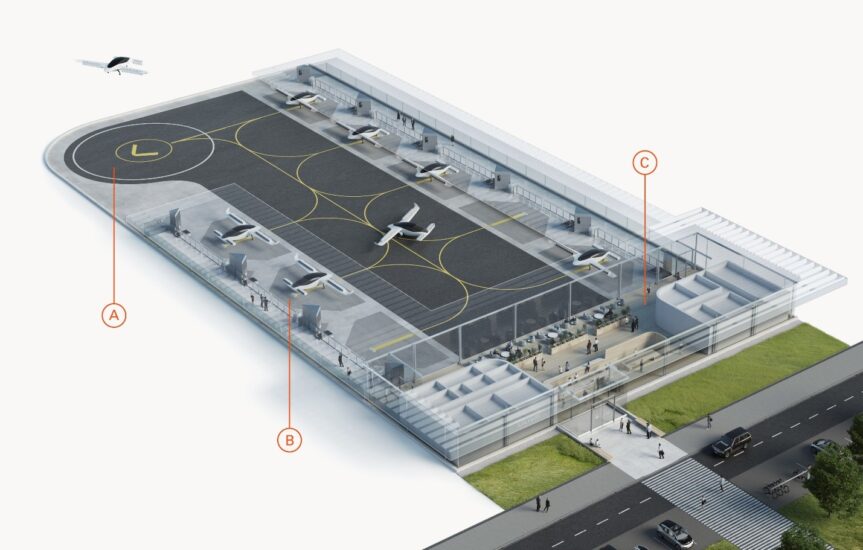Power Zone: Vertiports Will Need to Amp Up Their Electric Grids

To keep the tens — maybe hundreds — of thousands of eVTOLs poised to proliferate our low-altitude skies in the not-too-distant future, the vertiports from which they operate will need to power up. That is to say, in order for advanced air mobility (AAM) to advance rapidly, these facilities will need the ability to provide electricity, perhaps in the form of microgrids, to facilitate rapid, easily accessible charging.
To bring some specificity to that challenge, the U.S. National Renewable Energy Laboratory (NREL) conducted a study for the FAA in March of 2024 to identify the limiting factors and provide some solutions to speed up the introduction and adoption of AAM into society’s routine transportation regime.
Megawatts Up, Way Up
According to NREL researcher Bharat Solanki, the standard vertiport will need approximately 300 kilowatts. Ali Ilyas, head of electrification at U.K. Skyports Infrastructure, believes it will be closer to 1.5 to 2 megawatts of power, an amount equivalent to up to 2,000 homes. Equally significant Solanki notes, is that the power demands a vertiport will require will be variable based on flight schedules and weather conditions. That, Solanki says, may result in inconsistent power quality, such as voltage dips or power distribution to areas fed by the same substation.
To facilitate smooth charging and discharging operations, the NREL study recommends power storage and generation on-site at vertiports. Absent that, local utility providers may need to upgrade their own infrastructure by adding voltage regulators, overhead or underground lines, and additional transformers. That’s not to say other measures can’t be deployed: managed charging or synchronized operations could also have a positive impact if eVTOL manufacturers and vertiport operators work together to optimize electric supplies and management.
Optimal Ops
Several operational factors — demand calculations, battery charging profiles, a battery’s state of charge (its remaining capacity relative to its age) — are best managed when AAM mission profiles are also taken into consideration. “This approach, combined with pre-determined high-throughput flight schedules, allows for forecasting of charging schedules,” he said. “This enables the smart power system to prepare and program the power infrastructure for daily power consumption needs with a highly-efficient and optimized incorporation of microgrid solutions and energy management systems.”
Skyports includes several factors such as demand calculations and simulated battery charging profiles.
Ilyas also explained that it’s important that a battery’s “state of charge” — its remaining capacity at a given time and in relation to its age-related performance issues — be carefully moderated based on AAM mission profiles to maximize battery life.
“This approach,” Ilyas explains, “combined with pre-determined high-throughput flight schedules, allows for forecasting of charging schedules,” he said. “This enables the smart power system to prepare and program the power infrastructure for daily power consumption needs with a highly-efficient and optimized incorporation of microgrid solutions and energy management systems.”
L.E.K. Consulting, a consultancy with offices in the U.S., E.U., and APAC, estimates the cost building a vertiport in a major metropolis to be between USD 3.5 million and USD $12 million. There are three subsets of vertiport:
- Vertihubs — freestanding facilities which L.E.K. Consulting projects might cost USD $7 million to build
- Vertibases — might have three take off, landing, parking, and maintenance spaces and could be newly constructed or built on existing rooftops and come in around USD$500,000 to USD$700,000 to build
- Vertipads — single vehicle spaces might cost between USD$200,000 to USD$400,000 to put up.
No Time Like the Present
Without the infrastructure necessary to support AAM, no one is taking off or landing anywhere. That, NREL’s Solanki explains that “the need for vertiports to engage early with utilities to discuss potential upgrades to distribution systems and any implications on tariffs or rates,” means the time for everyone to begin planning is now. Utilities, eVTOL manufacturers, vertiport planners, and operators need to understand charging needs per aircraft will be at the outset and down the road as demand increases. Ilyas added that vertiport planners need to consider spatial and structural limitations, cabling routes, ground support equipment, regulatory requirements among other site-specific considerations.
And, this is only the beginning: hydrogen power isn’t here yet, but it will be sooner than many expect. Having a strategy now to adapt five or 10 years down the road will smooth the way for the transition that is ultimately going to happen.



